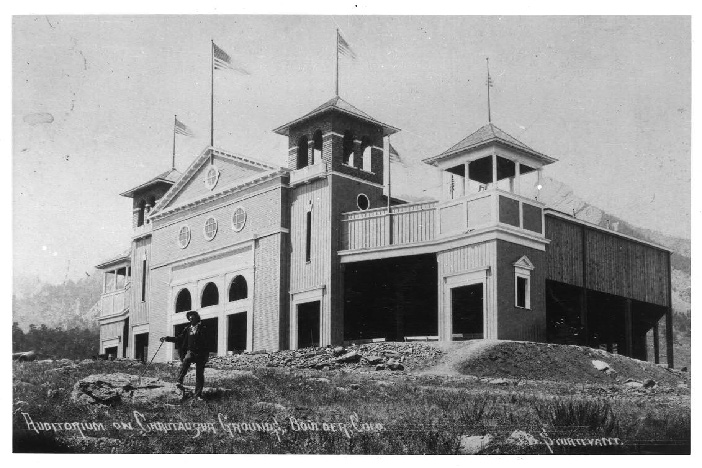Opening Day
The Auditorium and Dining Hall are the oldest buildings on the Chautauqua grounds. The Auditorium, built by contractor I.T. McAllister, was finished in 54 days, at a cost of $7000. It had open sides, a dirt-and-sawdust floor, and benches to seat 6000 people. With the slightest breeze, dense clouds of dust filled the air.
The Dining Hall, built by the W.M. Windham Company, was started a week later than the Auditorium, finished a week earlier, and cost almost twice as much ($11,000). A dining hall was not a luxury but a necessity. The expected thousands of visitors would be living in tents, and the Texas-Colorado Chautauqua Association did not want people cooking in tents, not only for fear of fire but also to avoid attracting vermin and bears.
The Dining Hall seated 400 people and was “large and airy and daintily furnished,” stated the Texas-Colorado Chautauquan, a publication funded and distributed by the Colorado and Southern Railroad to promote Chautauqua. Wooden slat awnings on the south and east sides provided welcome shade for visitors who had walked up the hill from Baseline Road. The restaurant served luncheon and dinner, or as the Texans said, dinner and supper, for $5.00 per week or $0.35 per meal. An open-air café served bread, cold meats, and hot coffee all day long. During Chautauqua’s first season, Dining Hall staff also served formal outdoor meals they called picnics.
To “enhance the social tone of the Assembly,” college students from all over the country were hired as waiters and waitresses. Even though they received ten days of “rigorous training,” the Chautauquan warned that people who expect “all the comforts of a high-class hotel” had better vacation elsewhere.
Indeed. Chautauqua housed its first visitors in 150 tents manufactured by the Colorado Tent and Awning Company of Denver and rented by the Boulder Tent Syndicate. The platform tents, the largest of which could be rented for the entire season for $24.00, were furnished with items rented from J.R. Ward’s Auction House at extremely reasonable prices: Bedstead, springs, and mattress, $2.00; Table, kitchen, $0.50; Straight chair, $0.15; Washstand/dresser, $3.00; Rocking chair, $0.50; Bed sofas, $1.50 and $2.50.
The Chautauquan said that when decorated with rugs, pictures, flowers, and ferns, the tents were “very dainty and attractive apartments,” and “tenters preferred tenting to living in any house ever built.” But from the beginning there were complaints about tents being open to the weather, hard to keep clean, and lacking in privacy. Mark Twain observed, “Partitions were so thin that you could hear the women changing their minds.”
Realizing that without better housing the Chautauqua might fail, the Chautauqua Association encouraged locals to build rental cottages in time for the 1899 season. However, 150 new tents were also erected, and tents continued to be used until 1916.
Hot, dusty, noisy, breezy, buggy tents like those the guests slept in were also used for classes. The Texas-Colorado Chautauqua Summer School was the first university-level summer school in Colorado. In 1898 it enrolled 600 students, mainly teachers from Texas, in 51 classes.
Other tents included the Art Tent, where Mrs. Jean Sherwood presented lectures on art history; the Elocution Tent, where lessons in public speaking were offered; and most importantly, the Woman’s Headquarters Tent, which housed meetings of the Chautauqua Literary and Scientific Circle. This correspondence course, begun in 1878 by the founders of the New York Chautauqua Assembly, required students to read materials at home and then participate in group discussions with others in the program. It caught on, and soon there were thousands of CLSC reading circles across America, so when the Texas-Colorado Chautauqua opened, the CLSC already had a following in Colorado and Texas.
Whatever the discomforts of Opening Day at the Texas-Colorado Chautauqua, they were more than compensated for by the intellectual stimulation it offered participants.
